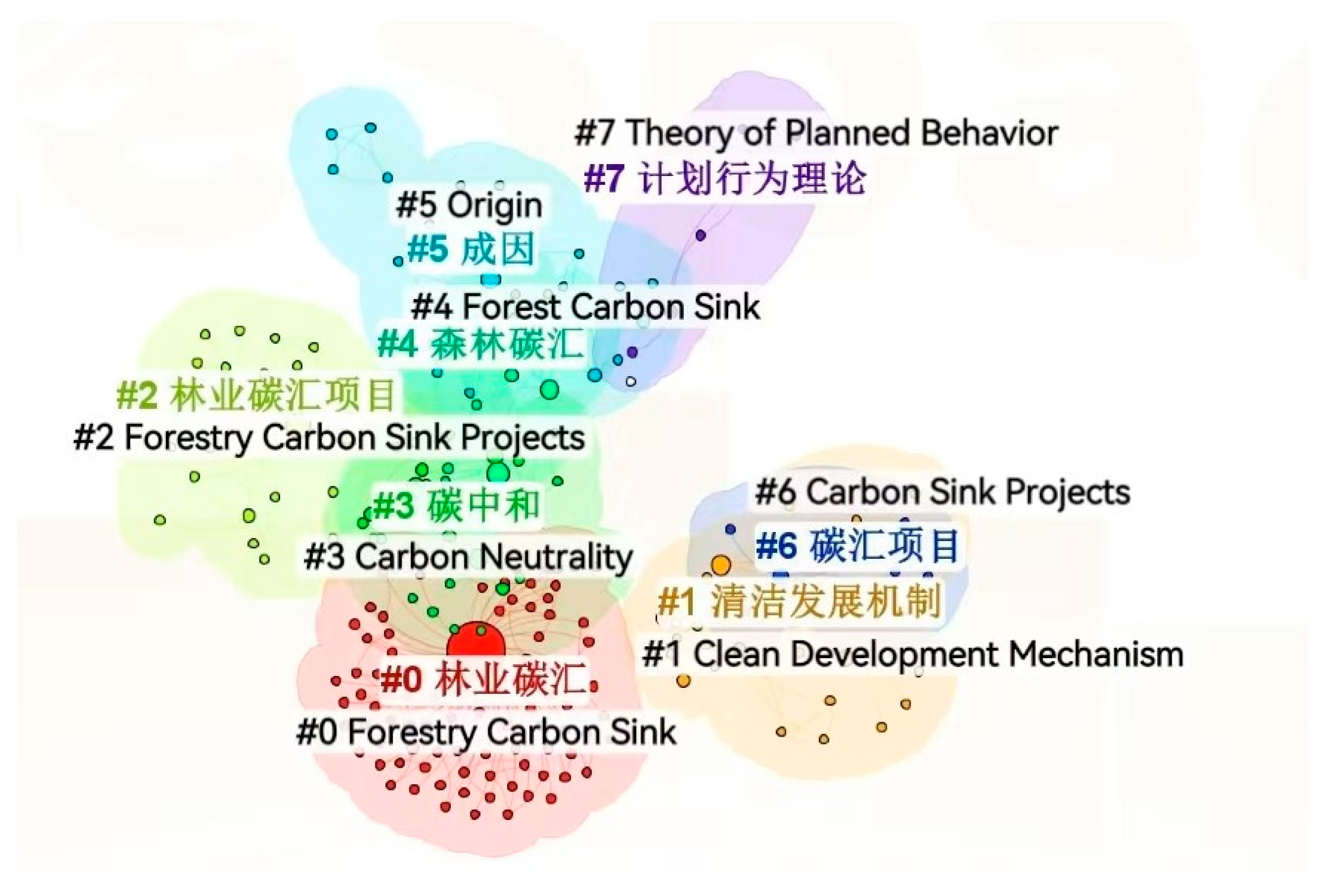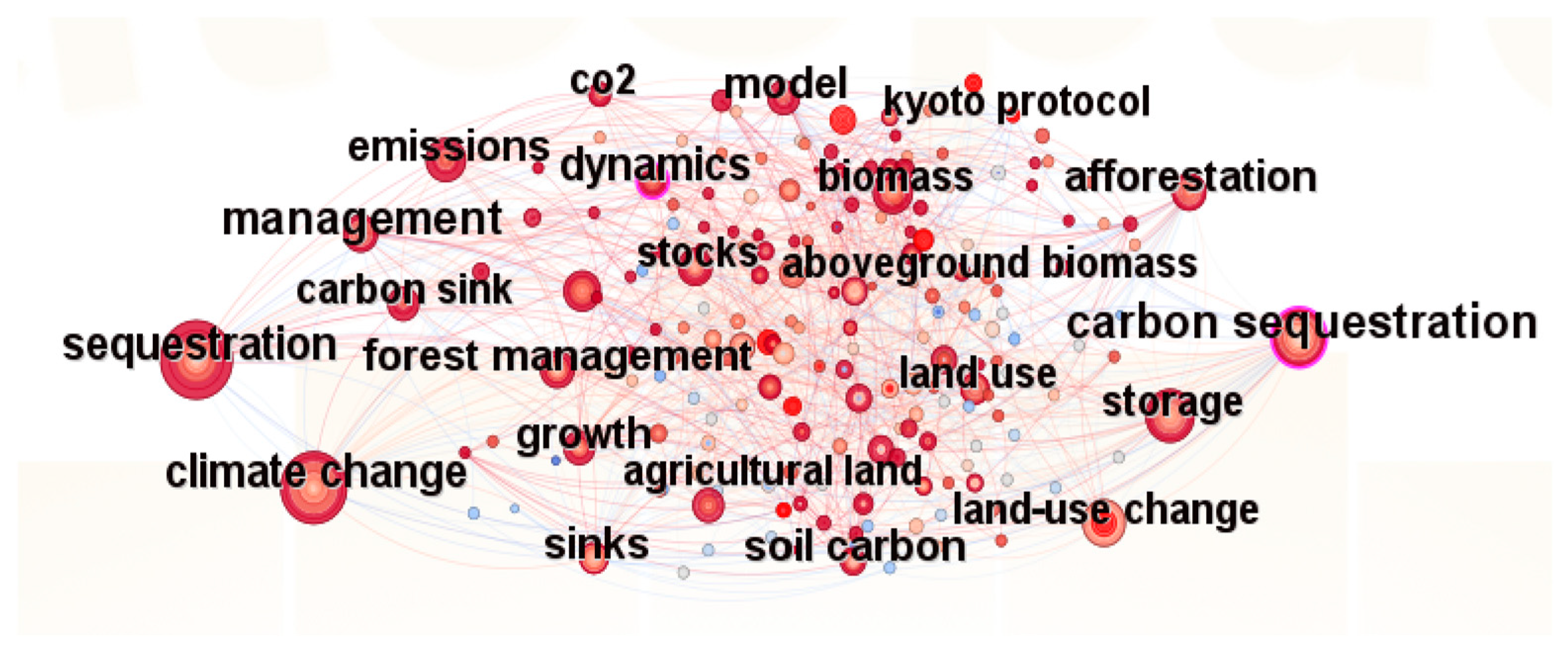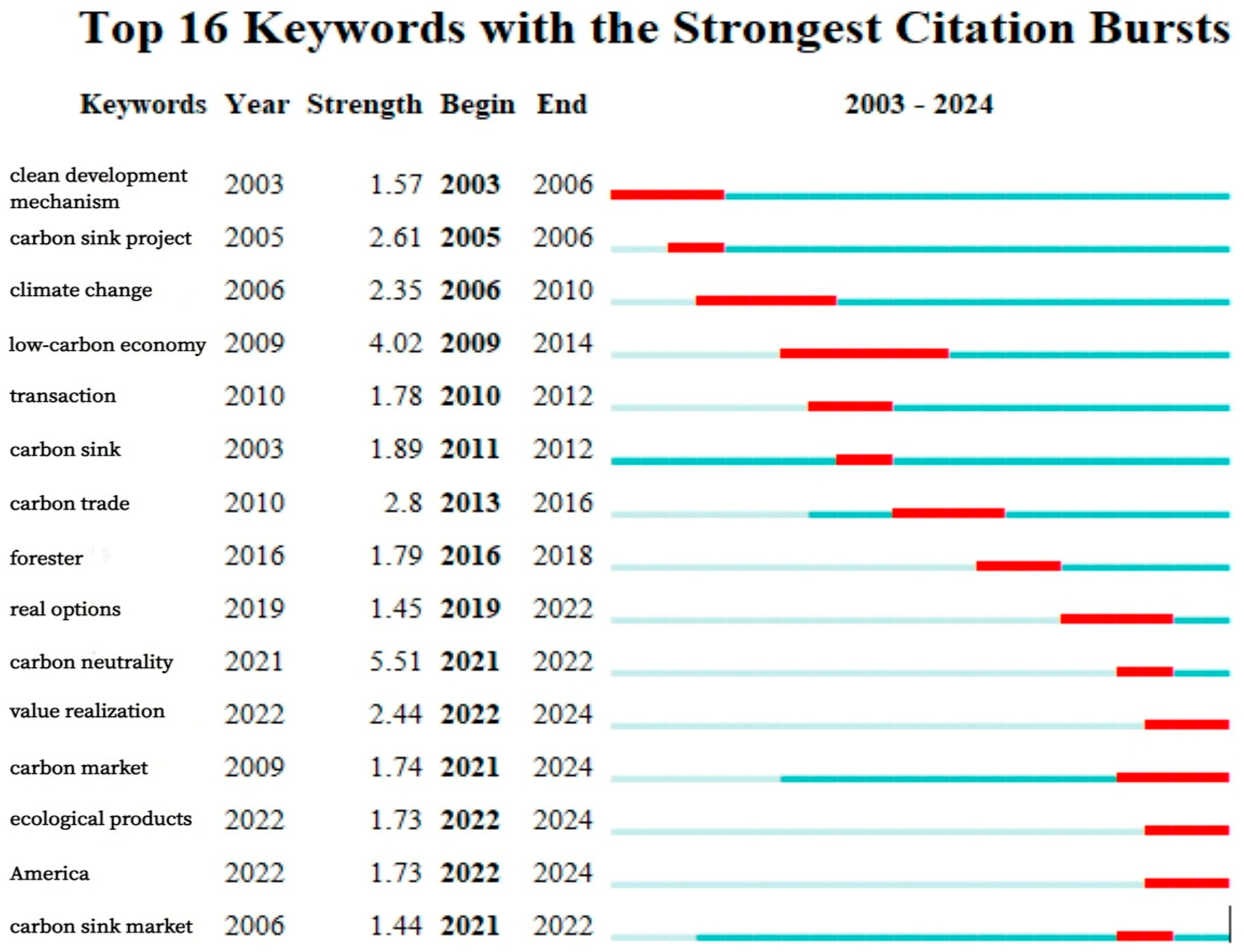Research Status and Trend Analysis of Forestry Carbon Sinks: A Systematic Literature Review
Abstract
1. Introduction
2. Data Sources and Research Methodology
2.1. Data Sources
2.2. Research Methodology
3. Results
3.1. Analysis of Relevant Countries and Issuing Authorities
3.2. Keyword Co-Occurrence and Cluster Analysis of the Chinese-Language Literature
3.3. Keyword Co-Occurrence and Cluster Analysis of the English-Language Literature
3.4. Analysis of Research Frontiers and Trends in the Chinese-Language Literature
3.5. Analysis of Research Frontiers and Trends in the English-Language Literature
4. Discussion
- (1)
- Policy orientation plays a significant role in shaping the direction and priorities of forestry carbon sink research. At the international level, multilateral climate agreements such as the Kyoto Protocol and the Paris Agreement have explicitly identified forest carbon sinks as essential tools for achieving greenhouse gas emission reduction targets. These agreements have driven extensive global research into carbon sink mechanisms, carbon trading systems, and MRV (Monitoring, Reporting, and Verification) frameworks. In particular, governments in countries such as the European Union, Canada, and Australia have actively promoted the development of carbon markets and the standardization of forestry carbon projects through legislation and financial incentives. These policy measures have steered academic research toward technical approaches and institutional design, with a focus on carbon accounting methodologies, project validation mechanisms, and the valuation of carbon assets.In China, the policy-driven nature of forestry carbon sink research is even more pronounced. Since the announcement of the “dual carbon” goals—carbon peaking and carbon neutrality—the government has significantly increased policy support for afforestation, the realization of ecological product value, and green finance. This has prompted domestic scholars to concentrate on practical issues such as carbon sink valuation, the development of carbon trading mechanisms, the design of ecological compensation schemes, and the distribution of benefits in forestry carbon projects.
- (2)
- Differences in research management systems and funding allocation have exerted a notable influence on the direction and nature of academic research. In China, research on forestry carbon sinks primarily relies on nationally designated special projects. This vertically structured management system, while effective in accelerating the implementation of policy objectives, tends to inhibit cross-institutional collaboration. For example, due to constraints imposed by administrative hierarchies, research institutions often face challenges such as data barriers and redundant studies. This stands in contrast to the European Union’s Horizon program, which promotes open and transnational research networks that encourage interdisciplinary and cross-border cooperation. China’s top-down policy implementation has accelerated the development of carbon market infrastructure; however, it has also tended to constrain interdisciplinary innovation. In contrast, international research has benefited from bottom-up experimentation, such as community-driven agroforestry initiatives in Tanzania and Indigenous-led carbon offset programs in Canada. These structural differences help explain why Chinese research tends to place greater emphasis on policy design, whereas the international literature focuses more heavily on ecological modeling and interdisciplinary approaches.
5. Conclusions
Supplementary Materials
Author Contributions
Funding
Data Availability Statement
Conflicts of Interest
References
- IPCC. Impacts, Adaptation and Vulnerability. Contribution of Working Group II to the Fourth Assessment Report of the Intergovernmental Panel on Climate Change. 2023. Available online: https://www.ipcc.ch/report/ar6/wg2/ (accessed on 19 February 2025).
- Guterres, A. Secretary-General’s Remarks at Opening of World Climate Action Summit. 2023. Available online: https://www.un.org/sg/en/content/sg/statement/2023-12-01/secretary-generals-remarks-opening-of-world-climate-action-summit-delivered (accessed on 19 February 2025).
- Du, X.W. Thoughts on strategies and paths to achieve carbon peaking and carbon neutrality in China. Front. Energy 2023, 17, 324–331. [Google Scholar] [CrossRef]
- IPCC. Special Report on Climate Change and Land. 2022, p. 807. Available online: https://www.ipcc.ch/site/assets/uploads/sites/4/2022/11/SRCCL_Annex-I-Glossary.pdf (accessed on 19 February 2025).
- Bäckstrand, K.; Lövbrand, E. Planting trees to mitigate climate change: Contested discourses of ecological modernization, green governmentality and civic environmentalism. Glob. Environ. Politics 2006, 6, 50–75. [Google Scholar] [CrossRef]
- Hurteau, M.D. The role of forests in the carbon cycle and in climate change. In Climate Change; Letcher, T.M., Ed.; Elsevier Press: Amsterdam, The Netherlands, 2021; pp. 561–579. [Google Scholar] [CrossRef]
- Zhu, J. Comprehension and Application of Some Legal Issues in the Forestry Carbon Sequestration. Law Appl. 2023, 1, 141–149. [Google Scholar]
- Povellato, A.; Bosello, F.; Giupponi, C. Cost-effectiveness of greenhouse gases mitigation measures in the European agro-forestry sector: A literature survey. Environ. Sci. Policy 2007, 10, 474–490. [Google Scholar] [CrossRef]
- Nijnik, M.; Pajot, G.; Moffat, A.J.; Slee, B. An economic analysis of the establishment of forest plantations in the United Kingdom to mitigate climatic change. For. Policy Econ. 2013, 26, 34–42. [Google Scholar] [CrossRef]
- van Kooten, G.C.; Sohngen, B. Economics of Forest Ecosystem Carbon Sinks: A Review. Int. Rev. Environ. Resour. Econ. 2007, 1, 237–269. [Google Scholar] [CrossRef]
- Baccini, A.; Walker, W.; Carvalho, L.; Farina, M.; Sulla-Menashe, D.; Houghton, R.A. Tropical forests are a net carbon source based on aboveground measurements of gain and loss. Science 2017, 358, 230–234. [Google Scholar] [CrossRef]
- Makkonen, M.; Huttunen, S.; Primmer, E.; Repo, A.; Hildén, M. Policy coherence in climate change mitigation: An ecosystem service approach to forests as carbon sink and bioenergy sources. For. Policy Econ. 2015, 50, 153–162. [Google Scholar] [CrossRef]
- Zakeri, A.; Dehghanian, F.; Fahimnia, B.; Sarkis, J. Carbon pricing versus emissions trading: A supply chain planning perspective. Int. J. Prod. Econ. 2015, 164, 197–205. [Google Scholar] [CrossRef]
- Yang, B.W. “Resource curse” or “institutional failure”? An analysis based on China’s forestry carbon sequestration and trading system. China Rural Surv. 2021, 5, 51–70. [Google Scholar] [CrossRef]
- Shen, Q.; Sun, Q.; Zhao, A. Bibliometric analysis of research on China’s rural environmental governance in CNKI and WOS. Front. Environ. Sci. 2024, 12, 1429595. [Google Scholar] [CrossRef]
- Xu, H.; Lin, X.; Shi, K.; Lin, S.; Zheng, G.; Wang, Q.; Dong, J.; Wang, M. Research Progress and Hotspot Evolution Analysis of Landscape Microclimate: Visual Analysis Based on CNKI and WOS. Int. J. Environ. Res. Public Health 2022, 19, 15118. [Google Scholar] [CrossRef]
- Mongeon, P.; Paul-Hus, A. The journal coverage of Web of Science and Scopus: A comparative analysis. Scientometrics 2016, 106, 213–228. [Google Scholar] [CrossRef]
- Lv, H.; Shi, A. Setting the Forestry Carbon Sink Insurance compensation standard for reducing losses from forest fires: An empirical study estimating CO2 emissions from forest fires in a sample of 15 provinces. Front. Environ. Sci. 2023, 11, 1112525. [Google Scholar] [CrossRef]
- Moher, D.; Liberati, A.; Tetzlaff, J.; Altman, D.G.; PRISMA Group. Preferred reporting items for systematic reviews and meta-analyses: The PRISMA statement. PLoS Med. 2009, 6, e1000097. [Google Scholar] [CrossRef]
- Chen, C.M. Citespace ii: Detecting and visualizing emerging trends and transient patterns in scientific literature. J. Am. Soc. Inf. Sci. Technol. 2006, 57, 359–377. [Google Scholar] [CrossRef]
- Wang, W.; Lu, C. Visualization analysis of big data research based on CiteSpace. Soft Comput. 2020, 24, 8173–8186. [Google Scholar] [CrossRef]
- Leeuwen, T.N. The application of bibliometric analyses in the evaluation of social science research. Who benefits from it, and why it is still feasible. Scientometrics 2006, 66, 133–154. [Google Scholar] [CrossRef]
- Yan, S.; Pang, M.; Wang, J.; Chen, R.; Liu, H.; Xu, X.; Li, B.; Li, Q.; Kong, F. A comparative study of bibliometric analysis on old adults’ cognitive impairment based on Web of Science and CNKI via CiteSpace. Health Econ. Rev. 2023, 13, 56. [Google Scholar] [CrossRef]
- Thunberg, G. Greta Thunberg to World Leaders: ‘How Dare You?’ 2019. Available online: https://news.un.org/en/story/2019/09/1047052 (accessed on 3 May 2025).
- Fang, J.Y.; Guo, Z.D.; Pu, S.L.; Chen, A.P. Terrestrial vegetation carbon sinks in China, 1981–2000. Sci. China Ser. D Earth Sci. 2007, 50, 1341–1350. [Google Scholar] [CrossRef]
- Wang, L. Comparison of some major ways reducing carbon emission or increasing carbon sink. Quat. Sci. 2004, 24, 191–197. [Google Scholar]
- Cao, Y.N.; Li, H.Y. The Role of Forestry Carbon Sinks in Climate Change Mitigation. For. Sci. Technol. Inf. 2024, 56, 84–87. [Google Scholar]
- Jiang, X.; Huang, Z.H. Analysis of China’s forestry carbon sink potential under the new economic normal. China Rural Econ. 2016, 11, 57–67. [Google Scholar] [CrossRef]
- Hu, A.G. China’s goal of achieving carbon peak by 2030 and its main approaches. J. Beijing Inst. Technol. (Soc. Sci. Ed.) 2021, 21, 1–15. [Google Scholar] [CrossRef]
- Liu, H.; Wang, H.; Nong, H.; He, Y.; Chen, Y.; Wang, H.; Yu, M. Opportunities and implementation pathway for China’s forestry development under the “Dual Carbon” strategy. Carbon Res. 2024, 3, 59. [Google Scholar] [CrossRef]
- Cao, X.L.; Cheng, B.D. Market Development of Forestry Carbon Sequestration Project of China Certified Emission Reduction: Current Situation, Challenges and Suggestions. Environ. Prot. 2018, 46, 27–34. [Google Scholar] [CrossRef]
- Wu, H.J.; Shi, H.Q.; Wang, J.W.; Liao, W.M. The Development Context and Prospect of Forestry Carbon Sink in the New Century—Visual Analysis Based on the CiteSpace. China Agron. Bull. 2023, 39, 41–50. [Google Scholar] [CrossRef]
- Xu, S. Forestry offsets under China’s certificated emission reduction (CCER) for carbon neutrality: Regulatory gaps and the ways forward. Int. J. Clim. Change Strateg. Manag. 2024, 16, 140–156. [Google Scholar] [CrossRef]
- Su, L.; Pan, M.Y.; Chen, L.R. Binary Tree Option Pricing Model Assess the Value of Forestry Carbon Sink Projects. For. Econ. Issues 2020, 40, 8–13. [Google Scholar] [CrossRef]
- Pan, G.; Zhang, S.; Peng, H. The Value Evaluation of Forestry Carbon Sinks by Binomial Tree Real Options Based on Hartman Model. Issues For. Econ. 2023, 43, 209–215. [Google Scholar] [CrossRef]
- Zhang, F. Compliance Governance System Construction of Forestry Carbon Sequestration Trading. J. East China Univ. Politics Law 2024, 27, 109–123. [Google Scholar] [CrossRef]
- Hu, F. Optimization path of the guarantee mechanism for realizing the value of forestry carbon sink from the perspective of new quality productive forces. Price Mon. 2024, 12, 1–7. [Google Scholar] [CrossRef]
- Sohngen, B.; Mendelsohn, R.O. Valuing the impact of large-scale ecological change in a market: The effect of climate change on US timber. Am. Econ. Rev. 1998, 88, 686–710. [Google Scholar]
- Keenan, R.J. Climate change impacts and adaptation in forest management: A review. Ann. For. Sci. 2015, 72, 145–167. [Google Scholar] [CrossRef]
- Verkerk, P.J.; Costanza, R.; Hetemäki, L.; Kubiszewski, I.; Leskinen, P.; Nabuurs, G.J.; Potočnik, J.; Palahí, M. Climate-Smart Forestry: The missing link. For. Policy Econ. 2020, 115, 102164. [Google Scholar] [CrossRef]
- Peng, S.-S.; Piao, S.; Zeng, Z.; Ciais, P.; Zhou, L.; Li, L.Z.X.; Myneni, R.B.; Yin, Y.; Zeng, H. Afforestation in China cools local land surface temperature. Proc. Natl. Acad. Sci. USA 2014, 111, 2915–2919. [Google Scholar] [CrossRef]
- Harper, A.B.; Powell, T.; Cox, P.M.; House, J.; Huntingford, C.; Lenton, T.M.; Sitch, S.; Burke, E.; Chadburn, S.E.; Collins, W.J.; et al. Land-use emissions play a critical role in land-based mitigation for Paris climate targets. Nat. Commun. 2018, 9, 2938. [Google Scholar] [CrossRef]
- Baldocchi, D.D. ‘Breathing’ of the terrestrial biosphere: Lessons learned from a global network of carbon dioxide flux measurement systems. Aust. J. Bot. 2008, 56, 1–26. [Google Scholar] [CrossRef]
- Luyssaert, S.; Schulze, E.-D.; Börner, A.; Knohl, A.; Hessenmöller, D.; Law, B.; Ciais, P.; Grace, J. Old-growth forests as global carbon sinks. Nature 2008, 455, 213–215. [Google Scholar] [CrossRef]
- Pan, Y.; Birdsey, R.A.; Fang, J.; Houghton, R.; Kauppi, P.E.; Kurz, W.A.; Phillips, O.L.; Shvidenko, A.; Lewis, S.L.; Canadell, J.G.; et al. A Large and Persistent Carbon Sink in the World’s Forests. Science 2011, 333, 988–993. [Google Scholar] [CrossRef]
- He, Y.; Ren, Y. Can carbon sink insurance and financial subsidies improve the carbon sequestration capacity of forestry? J. Clean. Prod. 2023, 397, 136618. [Google Scholar] [CrossRef]
- Huang, P.Q.; Long, S.Q.; Zhang, S.H.; Chen, H. Optimal strategy of forestry carbon sink trading under government subsidy based on stochastic differential game of carbon emission reduction. J. Ind. Manag. Optim. 2024, 21, 1328–1354. [Google Scholar] [CrossRef]
- Baker, D.F.; Law, R.M.; Gurney, K.R.; Rayner, P.; Peylin, P.; Denning, A.S.; Bousquet, P.; Bruhwiler, L.; Chen, Y.; Ciais, P.; et al. TransCom 3 inversion intercomparison: Impact of transport model errors on the interannual variability of regional CO2 fluxes, 1988–2003. Glob. Biogeochem. Cycles 2006, 20, GB1002. [Google Scholar] [CrossRef]
- Daigneault, A.; Baker, J.S.; Guo, J.; Lauri, P.; Favero, A.; Forsell, N.; Johnston, C.; Ohrel, S.B.; Sohngen, B. How the future of the global forest sink depends on timber demand, forest management, and carbon policies. Glob. Environ. Change Hum. Policy Dimens. 2022, 76, 102582. [Google Scholar] [CrossRef]
- Mo, L.; Zohner, C.M.; Reich, P.B.; Liang, J.; de Miguel, S.; Nabuurs, G.-J.; Renner, S.S.; Hoogen, J.v.D.; Araza, A.; Herold, M.; et al. Integrated global assessment of the natural forest carbon potential. Nature 2023, 624, 92–101. [Google Scholar] [CrossRef]
- Ma, X.; Wu, L.; Zhu, Y.; Wu, J.; Qin, Y. Simulation of Vegetation Carbon Sink of Arbor Forest and Carbon Mitigation of Forestry Bioenergy in China. Int. J. Environ. Res. Public Health 2022, 19, 13507. [Google Scholar] [CrossRef]
- Feng, S.; Chen, K. The Impact of Forestry Carbon Sink on Land Use Space Based on FLUS Model. Processes 2023, 11, 608. [Google Scholar] [CrossRef]
- Zhang, Y.; Li, C.; Ji, X.; Yun, C.; Wang, M.; Luo, X. The knowledge domain and emerging trends in phytoremediation: A scientometric analysis with CiteSpace. Environ. Sci. Pollut. Res. 2020, 27, 15515–15536. [Google Scholar] [CrossRef]
- Wang, G.G.; Lu, D.; Gao, T.; Zhang, J.; Sun, Y.; Teng, D.; Yu, F.; Zhu, J. Climate-smart forestry: An AI-enabled sustainable forest management solution for climate change adaptation and mitigation. J. For. Res. 2025, 36, 7. [Google Scholar] [CrossRef]
- Seddon, N.; Smith, A.; Smith, P.; Key, I.; Chausson, A.; Girardin, C.; House, J.; Srivastava, S.; Turner, B. Getting the message right on nature-based solutions to climate change. Glob. Change Biol. 2021, 27, 1518–1546. [Google Scholar] [CrossRef]
- McFarland, B.J. Green Bonds, Landscape Bonds, and Rainforest Bonds. In Conservation of Tropical Rainforests; Evans, D.H., Ed.; Springer: Berlin/Heidelberg, Germany, 2018; pp. 409–437. [Google Scholar] [CrossRef]
- ICMA. Green Bond Principles: Voluntary Process Guidelines for Issuing Green Bonds. 2021. Available online: https://www.icmagroup.org/assets/documents/Sustainable-finance/2021-updates/Green-Bond-Principles-June-2021-100621.pdf (accessed on 19 March 2025).
- Page, M.J.; McKenzie, J.E.; Bossuyt, P.M.; Boutron, I.; Hoffmann, T.C.; Mulrow, C.D.; Shamseer, L.; Tetzlaff, J.M.; Akl, E.A.; Brennan, S.E.; et al. The PRISMA 2020 statement: An updated guideline for reporting systematic reviews. BMJ 2021, 372, n71. [Google Scholar] [CrossRef] [PubMed]








| Data Source | CNKI | Web of Science |
|---|---|---|
| Citation indexes | CSSCI; Peking University’s Chinese Core Journals | SSCI; SCIE |
| Years | 2003–2024 | 1992–2024 |
| Language | Chinese | English |
| Searching topic | #1 (Linye Tanhui) | #1 (carbon sinks OR offset carbon emissions) AND (afforestation OR reforestation) |
| #2 (Linye Gutan) | #2 (forestry carbon sinks) | |
| #1 OR #2 | #1 OR #2 | |
| Document types | “Articles” or “Reviews” | |
| No. | Country | Number of Publications | Betweenness Centrality |
|---|---|---|---|
| 1 | China | 184 | 0.16 |
| 2 | United States of America | 124 | 0.67 |
| 3 | Canada | 57 | 0.11 |
| 4 | Germany | 45 | 0.21 |
| 5 | United Kingdom | 35 | 0.14 |
| 6 | Australia | 34 | 0.05 |
| 7 | France | 27 | 0.08 |
| 8 | Finland | 25 | 0.03 |
| 9 | Italy | 21 | 0.12 |
| 10 | Switzerland | 19 | 0.10 |
| CNKI | WOS | ||||
|---|---|---|---|---|---|
| Issuing Institution | Number of Articles Issued | Betweenness Centrality | Issuing Institution | Number of Articles Issued | Betweenness Centrality |
| College of Economics and Management, Beijing Forestry University | 46 | 0.04 | Chinese Academy of Sciences (China) | 68 | 0.19 |
| College of Economics and Management, Northeast Forestry University | 27 | 0 | United States Department of Agriculture (USA) | 38 | 0.23 |
| College of Economics and Management, Nanjing Forestry University | 21 | 0.01 | University of California System (USA) | 26 | 0.12 |
| Zhejiang Agriculture and Forestry University | 22 | 0.01 | University of Helsinki (Finland) | 20 | 0.01 |
| College of Economics, Fujian Agriculture and Forestry University | 17 | 0.02 | Canadian Forest Service (Canada) | 14 | 0.04 |
| Institute of Forestry Science and Technology Information, China Academy of Forestry Sciences | 12 | 0 | Centre National de la Recherche Scientifique (France) | 10 | 0.05 |
| College of International Trade, Shanxi University of Finance and Economics | 7 | 0 | International Institute for Applied Systems Analysis (Australia) | 9 | 0.07 |
| State Forestry Administration Survey, Planning and Design Institute | 6 | 0 | Paris-Saclay University (France) | 8 | 0.04 |
Disclaimer/Publisher’s Note: The statements, opinions and data contained in all publications are solely those of the individual author(s) and contributor(s) and not of MDPI and/or the editor(s). MDPI and/or the editor(s) disclaim responsibility for any injury to people or property resulting from any ideas, methods, instructions or products referred to in the content. |
© 2025 by the authors. Licensee MDPI, Basel, Switzerland. This article is an open access article distributed under the terms and conditions of the Creative Commons Attribution (CC BY) license (https://creativecommons.org/licenses/by/4.0/).
Share and Cite
Gou, L.; Deng, W.; Yang, S. Research Status and Trend Analysis of Forestry Carbon Sinks: A Systematic Literature Review. Sustainability 2025, 17, 5379. https://doi.org/10.3390/su17125379
Gou L, Deng W, Yang S. Research Status and Trend Analysis of Forestry Carbon Sinks: A Systematic Literature Review. Sustainability. 2025; 17(12):5379. https://doi.org/10.3390/su17125379
Chicago/Turabian StyleGou, Lufeng, Wendan Deng, and Siwei Yang. 2025. "Research Status and Trend Analysis of Forestry Carbon Sinks: A Systematic Literature Review" Sustainability 17, no. 12: 5379. https://doi.org/10.3390/su17125379
APA StyleGou, L., Deng, W., & Yang, S. (2025). Research Status and Trend Analysis of Forestry Carbon Sinks: A Systematic Literature Review. Sustainability, 17(12), 5379. https://doi.org/10.3390/su17125379





